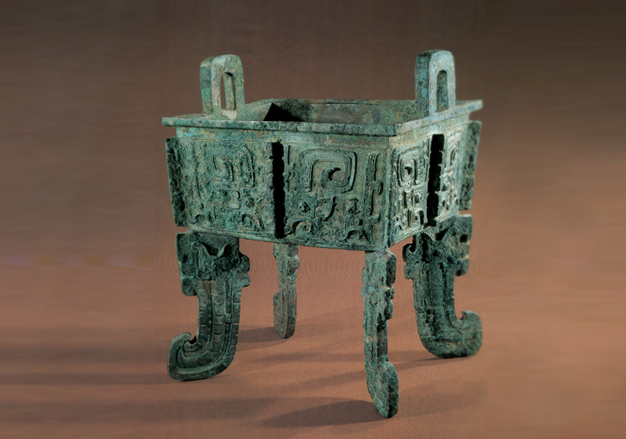Bronze cauldrons had evolved from pottery cauldrons of the New Stone Age. Whereas only one cauldron was buried in a tomb during the early Shang Dynasty, by the reign of King Wuding, cauldrons were used in pairs or even-numbered sets.
In terms of shape, cauldrons can be rectangular or round. The largest among them, such as Zhangzhai Cauldron from Erligang and Simuwu Cauldron from the Yin Ruins (Fig. 6), are all rectangular. The fact that such cauldrons have been found in royal or aristocratic tombs instead of small ones indicates the importance of rectangular cauldrons among Shang ritual vessels.
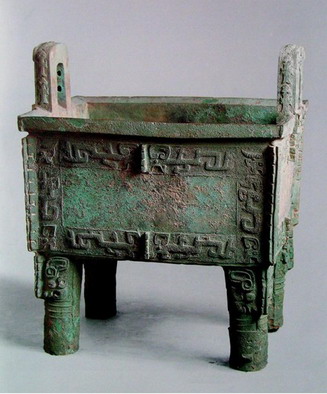
The two rectangular cauldrons with kui designs and blade-shaped legs were unearthed from Fu Hao's tomb at the Yin Ruins, in which were also found three other rectangular cauldrons having columnar legs. They bear the inscription of either fu hao or si mu xin. Those inscribed with fu hao (sometimes simply hao) were probably commissioned by Fu Hao herself, whereas those inscribed with si mu xin were commissioned by members of the royal family to be sacrificed to the tomb occupant, which bears out the high status she enjoyed.
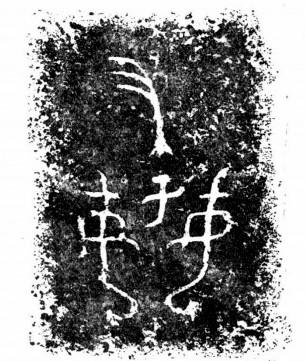
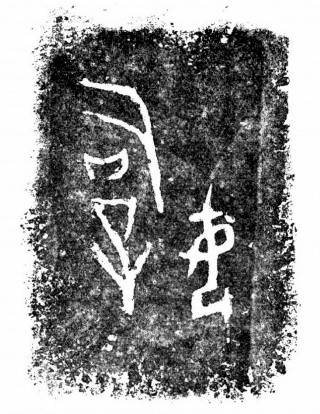
Shang cauldrons with blade-shaped legs are mostly either round or rectangular. Those made during the early and mid Shang Dynasty have rather deep bellies, which became more shallow toward the end of the dynasty. The legs are designed in a fairly practical way.
A round cauldron with blade-shaped legs and cloud-and-thunder designs (Fig. 9) was unearthed from the site of the Xiangyang Muslim Food Factory in Zhengzhou City, Henan Province. It measures 31.7 cm in overall height, 19 cm in mouth diameter, 15 cm in foot height, and 0.3 cm in wall thickness, with a weight of 1.85 kg.
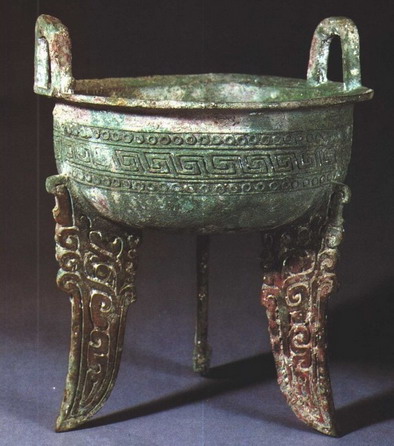
In 1958, a cauldron of the late Shang Dynasty named Zishen Fuji (Fig. 10) was unearthed at Yichuan County, Luoyang City, Henan Province. It is now in Huoyang Museum. It measures 25 cm in overall height and 25 cm in mouth diameter.
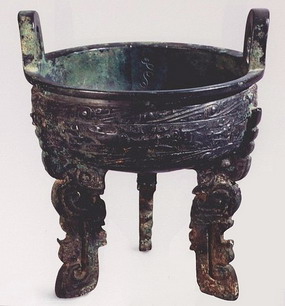
The late Shang Yade Fugeng Cauldron (Fig. 11), said to have been unearthed in Anyang, is now in Nanjing Museum. It measures 27.3 cm in overall height and 21.4 cm in mouth diameter.
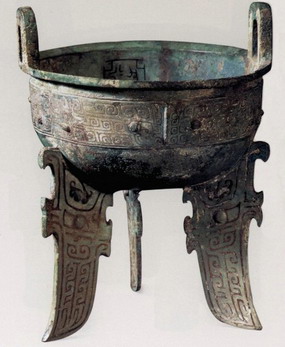
In 1984, a cauldron named Piwei (Fig. 12), which belongs to the third stage of the Yin Ruins, was unearthed from a Shang tomb in Qijiazhuang, Anyang City, Henan Province. It is now kept by the Archaeological Work Team of Anyang. It measures 16 cm in overall height and 13.7 cm in mouth diameter, with a weight of 0.8 kg.
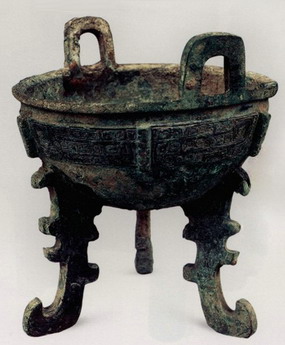
In 1978, a cauldron named Rongfuyi (Fig. 13), which belongs to the fourth stage of the Yin Ruins, was unearthed from a Shang tomb in the west of the Yin Ruins south of Xiaomintun in Anyang, Henan. It measures 19.5 cm in overall height and 15.8 cm in mouth diameter, with a weight of 1.85 kg. It is now kept in the Archaeological Institute of the Chinese Academy of Social Sciences.
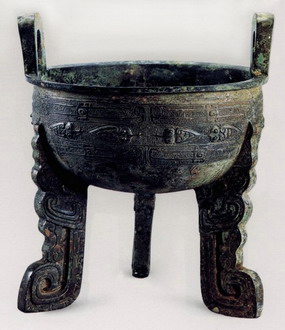
In 1986, a late Shang rectangular cauldron with blade-shaped legs named Cerong (Fig. 14) was unearthed from Tomb 8 in Subutun, Qingzhou City, Shandong Province. It measures 18.7 cm in overall height, 13.9 by 11.3 cm in mouth side, 5.1 cm in belly depth, and 10.7 cm in leg height. It is now in Shandong Museum.
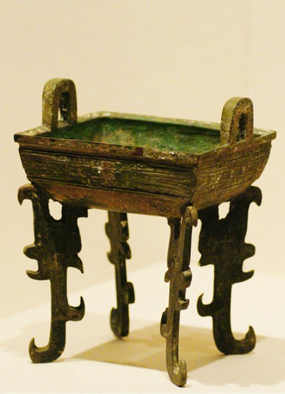
Jiangxi Provincial Museum houses a late Shang round bronze cauldron with upright handles and kui-shaped flat legs (Fig. 15), which measures 11 cm in overall height and 10.5 cm in mouth diameter.
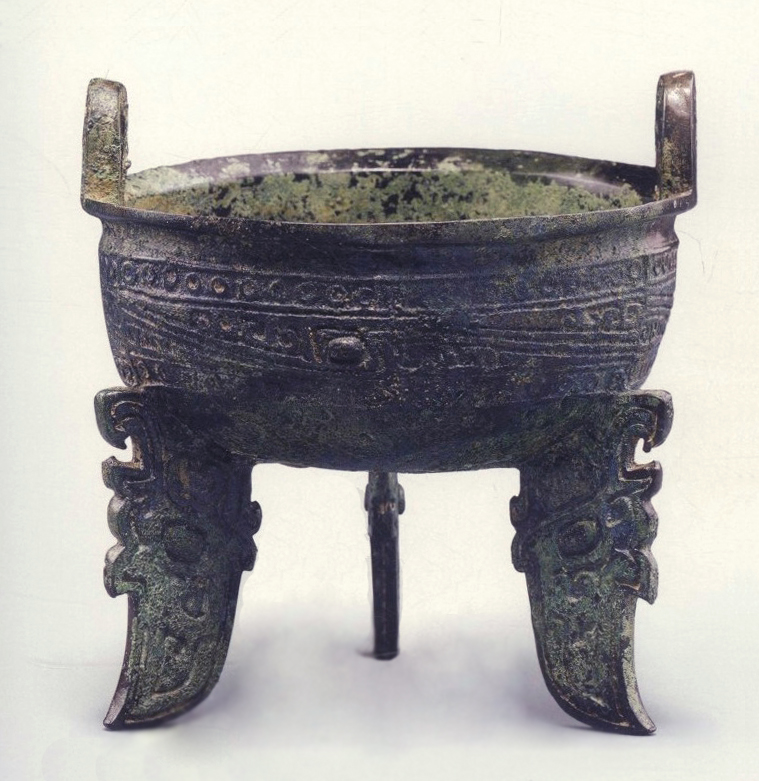
Also in this museum is a round bronze cauldron with upright ears and fish-shaped flat legs (Fig. 16), which measures 30 cm in overall height and 23.5 cm in mouth diameter.
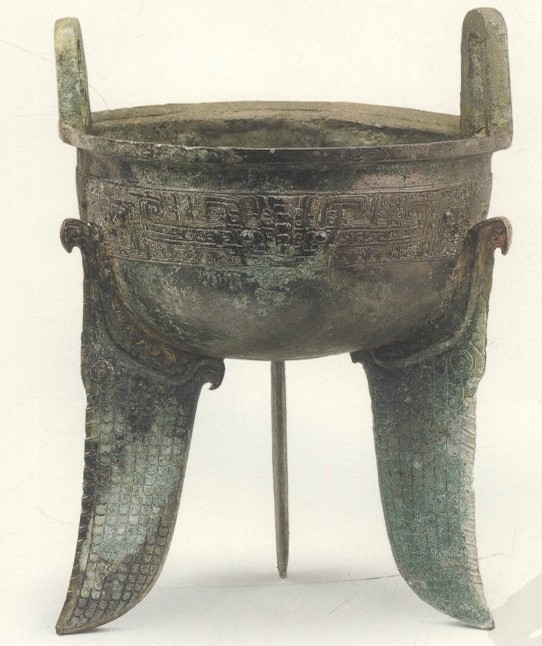
In the same museum are two round bronze cauldrons with tiger-shaped handles and tiger-shaped flat legs (Fig. 17). One of them measures 38.2 cm in overall height and 16.4 cm in mouth diameter, and the other measures 29 cm in overall height and 26.5 cm in mouth diameter.
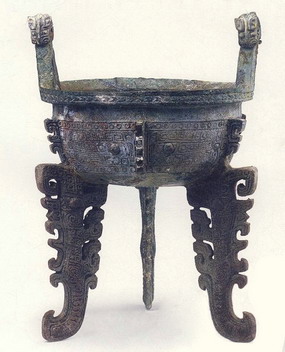
A comparison of the cauldrons with blade-shaped legs listed above may reveal the following:
First of all, most of the cauldrons with blade-shaped legs unearthed in Henan have the kui dragon as the thematic design for their blade-shaped legs. The forms of all these cauldron were derived from pottery of the New Stone Age and that of the succeeding Erlitou culture.
Round cauldrons with flag legs and cloud-and-thunder designs, which are among Erligang bronzes, are generally adorned with simple designs whereas rectangular cauldrons with kui designs and blade-shaped legs are covered with three layers of design. According to some scholars, the tips of the blade-shaped legs of the cauldrons of the early Shang Dynasty and the early Yin Ruins period touch the ground, those of such cauldrons of the mid Yin Ruins period point upward, and those of such cauldrons of the late Yin Ruins period bend upward and then curve downward to touch the ground on their inner edges.
The legs of a flag-legged cauldron is usually decorated with animal motifs--mostly the kui dragon on those found in the Central Plains. A rich variety of kui designs appeared at the second stage of the Yin Ruins. However, a sharp decline in formal variety and number occurred at the third and fourth stages in comparison with the middle of the second phase.
Secondly, kui designs of the Shang Dynasty are generally distributed in an area bordered by Yixian, Liaoning in the north, Guanghan, Sichuan in the west, Xingan, Jiangxi in the south, and Anji, Zhejiang in the east. While such kui designs found in Xingan and Qingjiang in Jiangxi mostly have two feet, those of the same type found in the Central Plains have a single leg or no leg at all. Besides, the legs of the blade-shaped-legged cauldrons unearthed at Dayangzhou in Xingan, Jiangxi are decorated with animals like tiger and fish, which are motifs evolved in a particular region. Such blade-shaped-legged cauldrons, which have distinct local characteristics, could have been the result of a fusion of the Central Plains culture and the local culture.
Furthermore, the blade-shaped-legged cauldrons unearthed at Dayangzhou in Xingan, Jiangxi number 14, or nearly 50% of all the bronze cauldrons (30 pieces altogether) unearthed from the 35 tombs containing bronze ritual vessels. In contrast, only one or two cauldrons have been found in each of the various tombs in the north. The predominance of the flag-legged cauldron in a set of bronze ritual vessels is a significant distinction between the bronze culture of the valley of the Ganjiang River and that of the Central Plains.
According to words on oracle bones, King Wuding held a number of unusual weddings for Fu Hao. Why did she marry so many kings?
Your answer please, if you have any questions or answer, please fell free to send us email, we are waiting for your answers and participation, and your comments, answers and suggestions will be highly appreciated. We will select and publicize the most appropriate answers and comments some time in the future.
Weekly Selection Email: meizhouyipin@chnmus.net
Dragon Designs on Bronzes
Dragon designs, traditionally known as kui or kui dragon designs, are one of the most common kinds of decoration on Shang and Zhou bronzes. They fall into the following categories:
The crawling dragon (Fig. 18) is usually in profile. At the front is the head with a mouth opened downward, a rather long snout, an upturned upper lip, and a downward or upturned lower lip. Behind the head is a snake-like tortuous body in a crawling posture, with one leg, two legs, or no leg at all. The tail coils upward. This was in wide use from the early Shang Dynasty to the early Western Zhou Dynasty.
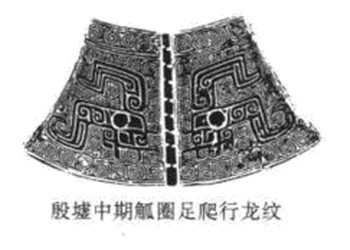
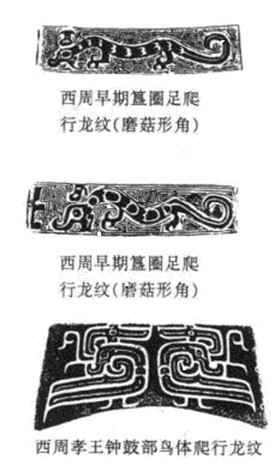
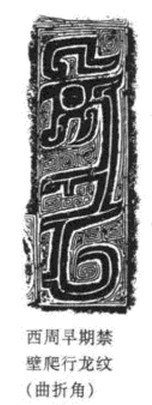
Fig. 18 Crawling dragon
Crawling dragon (with mushroom-shaped horn) on the ring foot of an early Western Zhou gui (food vessel)
Crawling dragon (with mushroom-shaped horn) on the ring foot of an early Western Zhou gui (food vessel)
Crawling dragon with bird’s body on the lower part of King Xiao of Western Zhou’s bell
Crawling dragon (with bent horn) on an early Western Zhou bronze jin (tray for drinking vessels)
The double-bodied dragon (Fig. 19) mainly features the front of the head, with the body extending to both sides. It usually appears on the long and narrow surface of a bronze vessel's neck. It was in wide use from the late Shang Dynasty to the mid Western Zhou Dynasty.
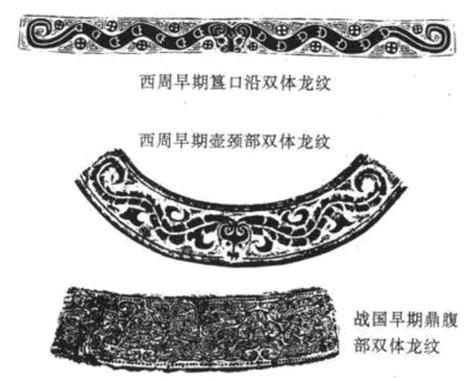
Double-bodied dragon on the neck of an early Western Zhou pot
Double-bodied dragon on the belly of a cauldron of the early Warring States Period
Fig. 19 Double-bodied dragon
The coiled dragon (Fig. 20) has a coiled body. One of the variations shows the front of the head at the center, which is surrounded by the circular body. It usually appears at the center of plates dating from between the late Shang Dynasty to the early Zhou Dynasty. Another variation, which shows the profile of a dragon coiled into a circle, is usually found on the lid of a gui (food vessel) or pot made between the Western Zhou Dynasty and the Spring and Autumn Period.
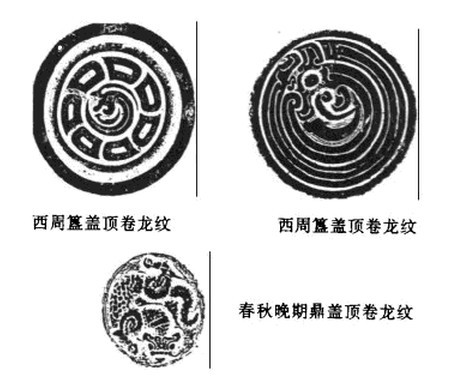
Coiled dragon on the top of the lid of a Western Zhou gui (food vessel)
Coiled dragon on the top of the lid of a cauldron of the late Spring and Autumn Period
Fig. 20 Coiled dragon
The double-headed dragon has one head at either end of the body. It is usually in a diagonal composition, with one head above the other. It is often seen on artifacts made between the Western Zhou Dynasty and the early Spring and Autumn Period.
Interlocking dragons (Fig. 11) are two or more dragons twisted around each other in a rather complicated composition. Traditionally called the coiled chi (hornless dragon in ancient folklore) design (or the coiled snake/lizard design if it is small), this was in wide use during the Spring and Autumn Period and the Warring States Period.
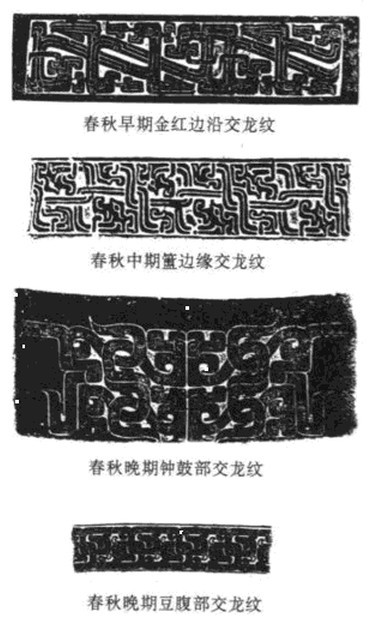
Interlocking dragons on the rim of a fu (food vessel) of the mid Spring and Autumn Period
Interlocking dragons on the lower part of a bell of the late Spring and Autumn Period
Interlocking dragons on the belly of a dou (food vessel) of the late Spring and Autumn Period
Fig. 21 Interlocking dragons
In 1976, staff members of the Archaeological Work Station of Anyang unearthed two rectangular cauldrons with kui designs and blade-shaped legs when excavating Fu Hao's tomb. One of them is now in Henan Museum, and the other is in the Museum of Chinese History [now a part of the National Museum of China].
Each of the two rectangular cauldrons has a rectangular mouth with a folded rim and right-angled edges, two handles standing upright on the edges of the two shorter sides, a waist slightly contracted downwards, a blade-shaped bottom a bit smaller than the mouth, and four long and blade-shaped solid legs shaped like kui dragons. Each cauldron is made up of handles, a belly, and blade-shaped legs, all of which are adorned with three layers of design. Each of the two handles is decorated on the outside with a pair of incised kui dragons whose heads are raised upward. The belly has a ridge in each of the four outside corners and one in the middle of each side, which functions as the nose of the typical ram's-horn-type bodiless beast mask the side is adorned with (Fig. 1). Each of the beast masks has eyes shaped like the Chinese character chen (臣) (Fig. 3) and is flanked by two inverted kui motif, one on each side (Fig. 4). The legs are decorated with kui designs on both sides (Fig. 5).
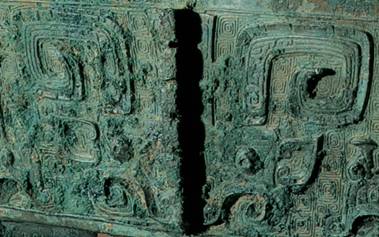
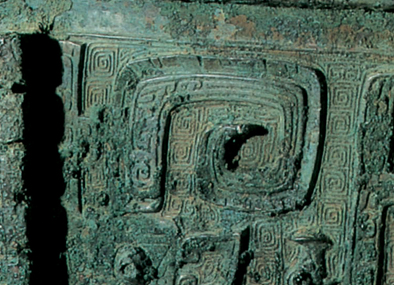
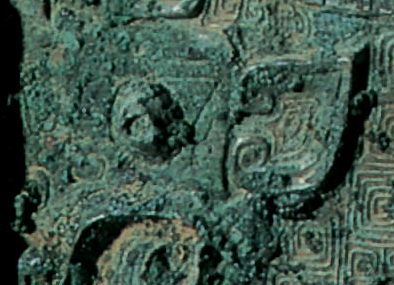
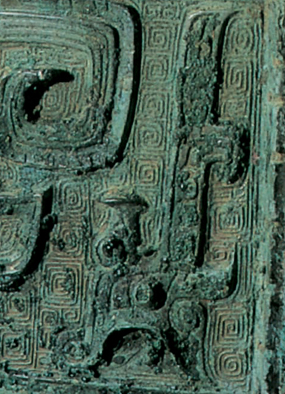
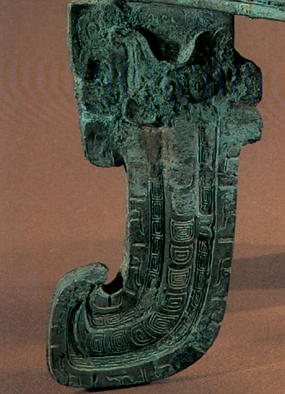
The two characters, Fu Hao, inscribed on the inner bottom of the cauldron provide important evidence for identifying the tomb occupant. Besides, with a magnificent form and the use of the typical 'three layers of design', the cauldron can serve as an important specimen for the study of bronze art.
